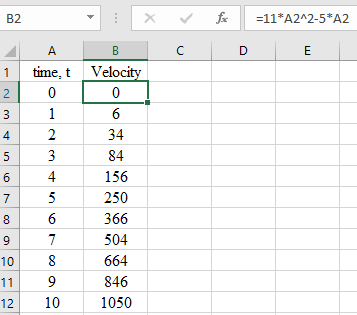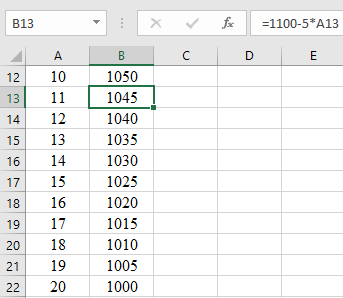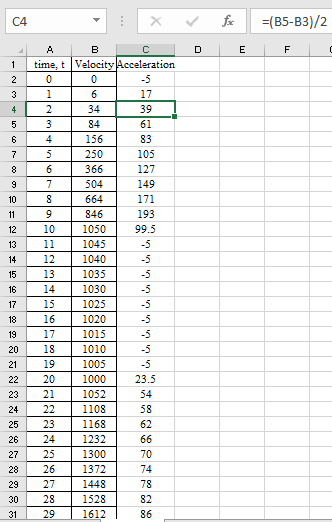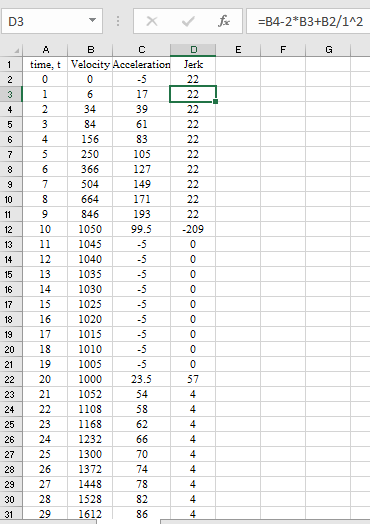
Employ the multiple-application Simpson's rule to evaluate the vertical distance traveled by a rocket if the vertical velocity is given by
In addition, use numerical differentiation to develop graphs of the acceleration
To calculate: The vertical distance travelled by the rocket if the vertical velocity in different time interval mentioned in the problem by using the multiple-application Simpson’s rule, and plot the graph between acceleration
Answer to Problem 45P
Solution:
The vertical distance travelled by the rocket is
The graph between acceleration
The graph between jerk
Explanation of Solution
Given Information:
The vertical velocity of the rocket is,
The acceleration is,
The jerk is,
Formula Used:
The expression for Simpson’s 1/3 rule is,
The expression for the distance is,
Write the first derivative forward difference formula.
Write the first derivative two-point central difference formula.
Write the first derivative backward difference formula.
Write the second derivative forward difference formula.
Write the second derivative two-point central difference formula.
Write the second derivative backward difference formula.
Calculation:
Recall the expression of the velocity.
Use the Excel to find the velocity at a different time.
For the range of
Open the Excel and substitute the respective time. Apply the formula in column B.

For the range of
Open the Excel and substitute the respective time. Apply the formula in column B.

For the range of
Open the Excel and substitute the respective time. Apply the formula in column B.

Thus, the velocity at every time is,
| time, t | Velocity |
| 0 | 0 |
| 1 | 6 |
| 2 | 34 |
| 3 | 84 |
| 4 | 156 |
| 5 | 250 |
| 6 | 366 |
| 7 | 504 |
| 8 | 664 |
| 9 | 846 |
| 10 | 1050 |
| 11 | 1045 |
| 12 | 1040 |
| 13 | 1035 |
| 14 | 1030 |
| 15 | 1025 |
| 16 | 1020 |
| 17 | 1015 |
| 18 | 1010 |
| 19 | 1005 |
| 20 | 1000 |
| 21 | 1052 |
| 22 | 1108 |
| 23 | 1168 |
| 24 | 1232 |
| 25 | 1300 |
| 26 | 1372 |
| 27 | 1448 |
| 28 | 1528 |
| 29 | 1612 |
| 30 | 1700 |
Recall the expression for the distance,
The expression for the distance is,
Use Simpson’s 1/3 rule tointegrate the above data.
Recall the expression for Simpson’s 1/3 rule.
Take the integral for the even space time,
Substitute all the value from the above table.
Solve further,
Solve further,
The total integral is equal to the sum of all individual integral.
Thus, the vertical distance travelled by the rocket is
Calculate the acceleration by numerical difference of the velocity.
Use the first derivative forward difference formula.
Substitute all the value from the time velocity table.
Calculate the acceleration for time
Substitute all the value from the time velocity table.
Similarly calculate all the value by using the Excel.

Use the first derivative backward difference formula to calculate acceleration for
Recall the first derivative backward difference formula.
Solve for
The below plot shows the relation between the Acceleration and time.
Write the expression for the Jerk.
Calculate the jerk by using the second order finite difference formula.
Write the second derivative forward difference formula.
Substitute all the value from the time velocity table.
Calculate the jerk for time
Substitute all the value from the time velocity table.
Similarly calculate all the value by using the Excel.

Use the second derivative backward difference formula to calculate acceleration for
Write the second derivative backward difference formula.
Solve for
The below plot shows the relation between the jerk and time.
Want to see more full solutions like this?
Chapter 24 Solutions
Numerical Methods for Engineers
- Algebra & Trigonometry with Analytic GeometryAlgebraISBN:9781133382119Author:SwokowskiPublisher:Cengage

 Big Ideas Math A Bridge To Success Algebra 1: Stu...AlgebraISBN:9781680331141Author:HOUGHTON MIFFLIN HARCOURTPublisher:Houghton Mifflin Harcourt
Big Ideas Math A Bridge To Success Algebra 1: Stu...AlgebraISBN:9781680331141Author:HOUGHTON MIFFLIN HARCOURTPublisher:Houghton Mifflin Harcourt


